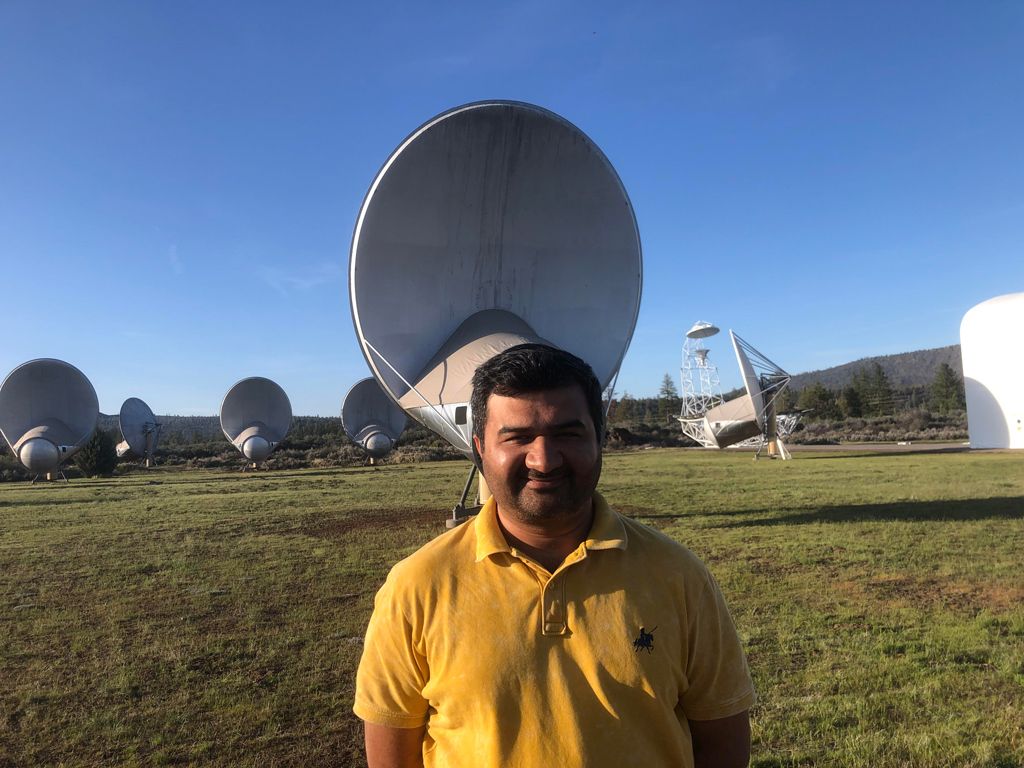
In early 2023, Dr. Vishal Gajjar packed up his house in the Bay Area to move to Hat Creek, California. No need to look up a map; you haven’t heard of it. It’s a tiny town nestled between beautiful mountains and green pastures dotted with cattle. It’s also home to the SETI Institute’s Allen Telescope Array (ATA), the only telescope purpose-built to search for advanced technology in the universe.
Unlike many scientists who had made the trek before him, Vishal didin’t come to the ATA alone. His wife and two-year old son joined him, making SETI a family affair.

We sat down with Vishal to learn more about his role at the ATA and what life has been like since moving onsite.
Q: What is your role at the ATA?
I was working with the ATA team and others at the SETI Institute for many years, but in February, I formally joined the SETI Institute as an astronomer. I came at a really exciting time because the recent refurbishment has made the telescope the prime instrument to use in SETI searches and other scientific pursuits. The first part of my job is to commission new capabilities for the array that could make it even more impactful. Secondly, I’m a SETI astronomer myself, so I’m using the ATA for SETI research. I’m really thrilled to be an official part of the SETI Institute community.
Q: What made you decide to make the jump to a full-time astronomer who lives on site at the ATA?
Well, nowadays, astronomers don’t have to be onsite to access telescope data or use the instrument for observations—most of that can be done online. But I still think it’s useful to visit instruments that I’m using for research to learn about things in a little more detail. I think there’s a strong future for what the ATA will be able to accomplish with its new capabilities, and I wanted to spend time out here so I could really understand the data—from collecting it to processing it.
Q: What are you currently working on at the ATA?
Right now, most SETI is searching for narrowband radio signals. This makes sense, but it doesn’t mean we should stop there. I’m designing different types of searches for different classes of signals that we haven’t looked for in the history of SETI. Now why the ATA when I could do this with other telescopes? The ATA has this really specific advantage that single dish telescopes don’t offer—it’s an interferometer. Rather than a single dish, an interferometer is a collection of smaller dishes spread out over a distance. (In the case of the ATA, 300 or 400.) And when you use all the dishes to observe a single location in the sky, it’s easier to eliminate local interference from Earth-based technology than when using a single, large dish. The ATA is giving us a place to design and deploy novel searches that we can use at future telescopes with even more sensitive observation capabilities .
Q: Was it a hard pitch to get your family to move onsite with you?
Well, we had been living in the Bay Area for a couple years, which is quite crowded, so my family was excited about living somewhere quieter. I have a two-year old, so he’s too young for school, and most things are remote now, which doesn’t change much for my wife. Where we’re living, the Lassen house, is surrounded by pine trees and open spaces. There’s a lot of hiking. I think it will be a harder pitch to move them out.

Q: What makes you excited about the search for life beyond Earth?
Throughout my astronomy education, I always had a keen interest in SETI. I think it’s at the forefront of human curiosity. When an astronomer gives a public talk, they will definitely get a question about the possibility of life in the universe. And that question also bothered me. If we, as humans, can make a small contribution to answering this most fundamental question that we’ve been asking for centuries, we have to. Even thinking about it me goosebumps—the possibility that someone is out there right now. This is the first time in human history that we have the tools that allow us to start answering this question.
Q: Do you think intelligent life exists beyond Earth?
I think so. If you look at the number of exoplanets we have discovered in the past decade, it’s overwhelming—even the number of Earth-like planets. Current statistics suggests that almost every star in our galaxy is expected to have a planet around it. Earth being the only place in the entire universe where life had a chance to start is a small possibility, and if life started here, it likely developed other places. There’s no doubt in my mind that life is there, so the question becomes, how do we find it? And, also, is it technologically advanced? We still have to do a lot of work here.
We should also understand that the timescale of the universe is quite large, and we are a very new species—only doing this for the past 50 or 60 years. There might have been a lot of advanced life before or maybe in the future, and we just missed them. This is a challenge.
Billions of dollars have been spent looking for signs of basic biology on exoplanets, and I think we should also invest more resources into the search for advanced life. There are a lot of abiotic processes that create biosignatures, but signs of technology would be evident.
So, yes, I believe technologically advanced life exists out there, and we should put more effort into finding it.
Q: What is your favorite memory about living onsite?
Well, right now, my parents are visiting, so there are three generations under the same roof. A few days after they arrived it snowed. My parents, who live in India where I grew up, had never seen snow. And my young son had also never seen it. It was a really special experience with my dad, mom, and son—them seeing snow for the first time and getting to play in it.







